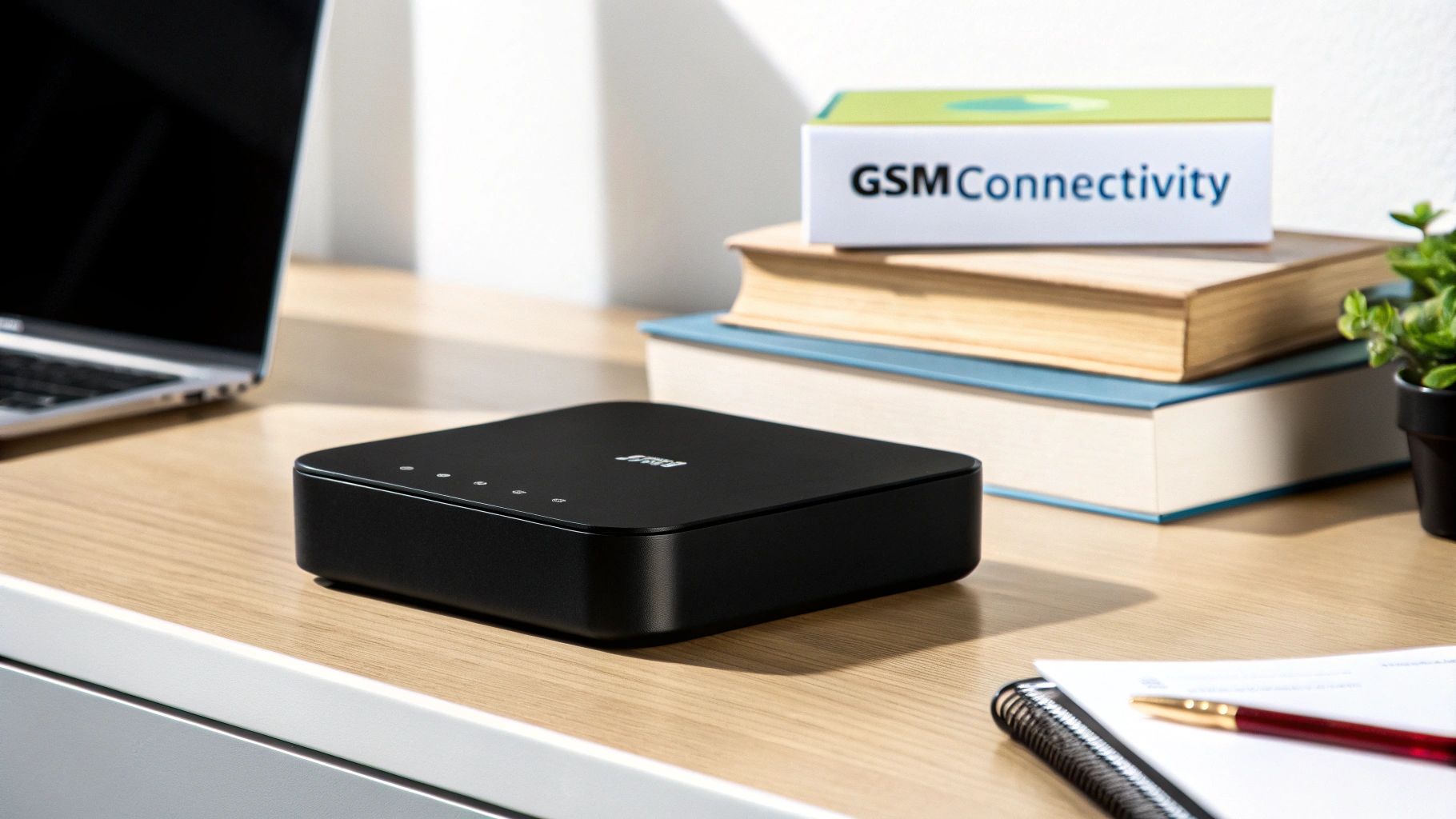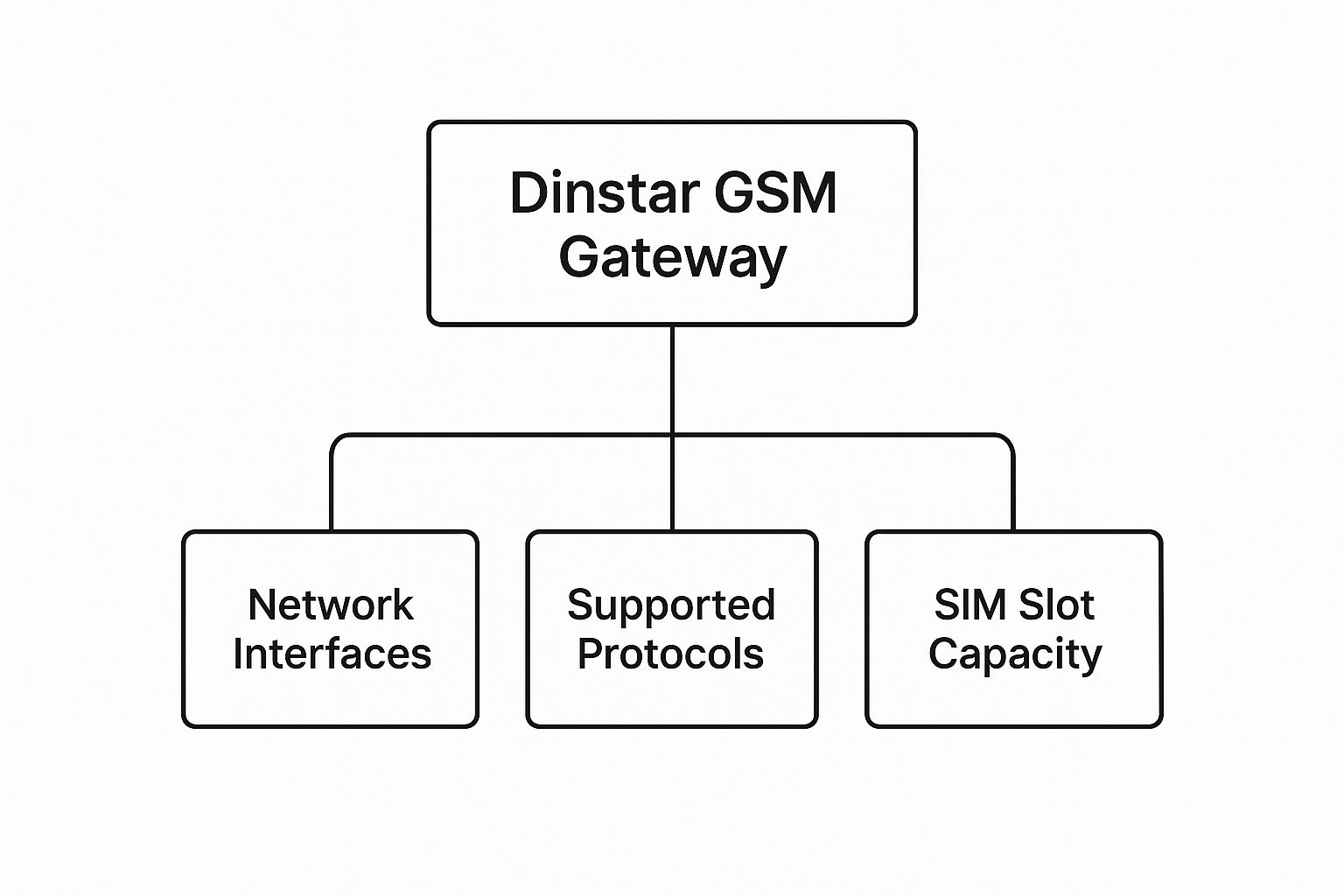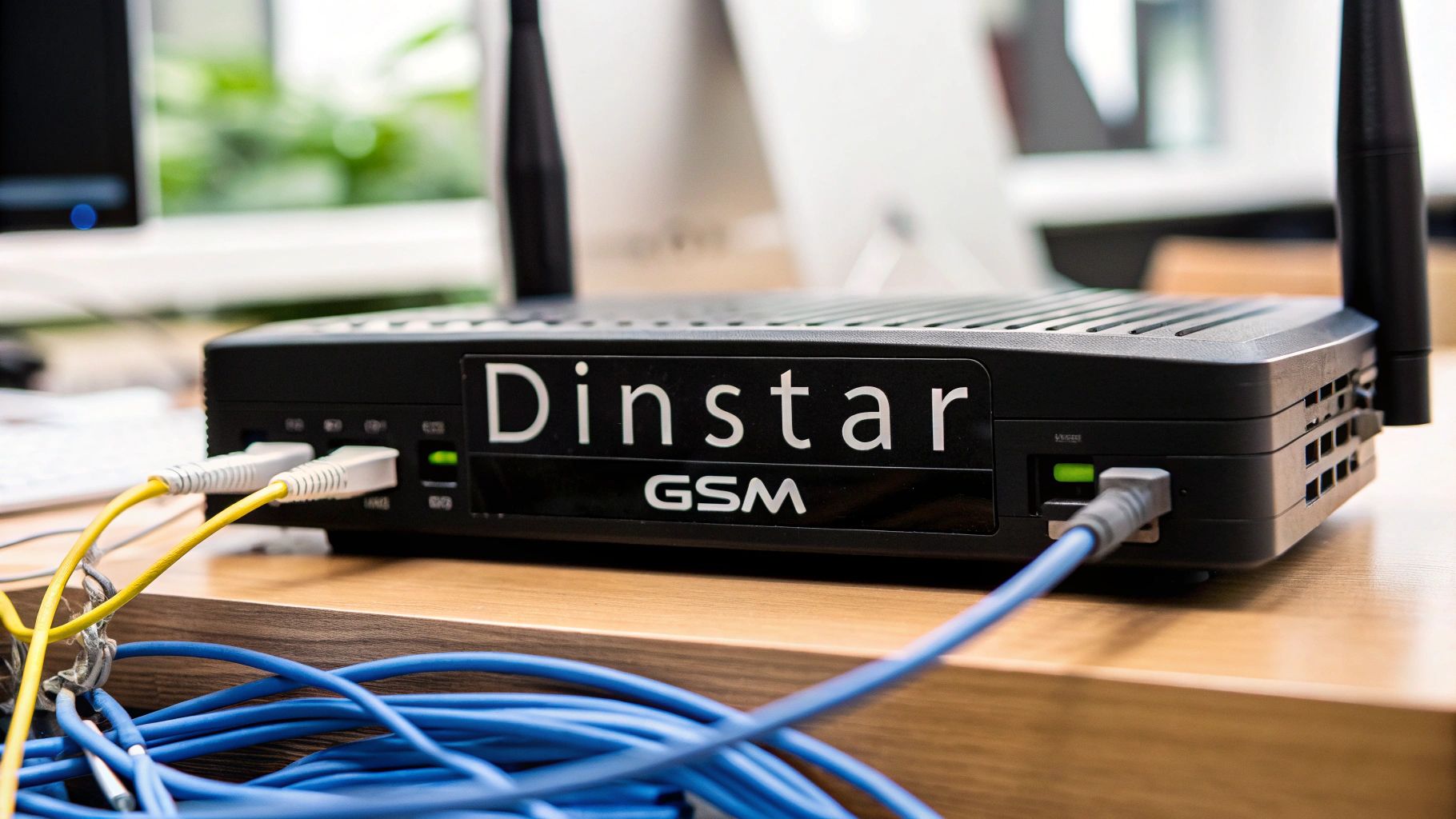Think of a Dinstar GSM gateway as a clever translator for your business phone system. It’s a specialized piece of hardware that creates a bridge between your modern VoIP setup and the vast world of cellular networks. This connection is the key to turning potentially expensive landline-to-mobile calls into much more affordable mobile-to-mobile ones.
What Is a Dinstar GSM Gateway and Why It Matters

Imagine your office phone system could automatically pick the cheapest route for every single outbound call. That’s exactly what a Dinstar GSM gateway does. It links your internal IP-PBX (the brain of your business phone network) directly to the GSM network—the very same one your smartphone uses every day.
So, when one of your team members needs to call a client’s mobile number, the call takes a smarter path. Instead of going through traditional, often costly telephone lines, the gateway steps in. It seamlessly channels the call through one of its internal SIM cards, making it appear as a call from a mobile number.
This simple rerouting can have a huge effect on your company's communication budget. It takes full advantage of the far more attractive mobile-to-mobile calling plans that carriers offer. For any business that makes a lot of calls to mobile numbers—think sales teams, busy contact centers, or logistics coordinators—the savings add up fast.
The Core Value Proposition
But it's not just about cutting costs. It’s about building a more reliable and adaptable communication system without having to rip and replace everything you already have. A Dinstar GSM gateway works with your existing infrastructure, simply making it better.
At its heart, a GSM gateway provides a direct, cost-effective path to the mobile world. It unlocks the potential to communicate reliably over cellular networks, giving businesses a powerful tool for cost control and improved connectivity.
This technology is becoming a go-to solution in modern business communications, especially in regions like the UAE where integrating VoIP and mobile is a top priority. In fact, market analysis points to major growth for these devices across the Middle East and Africa, fueled by widespread mobile use and the constant business need for more efficient communication. You can explore more about this market trend to see just how important this technology is becoming in the region.
Beyond Voice Calls
Modern Dinstar GSM gateways are much more than one-trick ponies for voice calls. Their capabilities now cover other essential business functions, making them an incredibly versatile tool.
Some of the key benefits include:
- SMS Functionality: You can send and receive text messages directly through the gateway. This is perfect for things like appointment reminders, marketing alerts, or security notifications like two-factor authentication.
- Call Termination: They provide a dependable endpoint for all your incoming calls, which helps ensure you stay connected even if your primary internet goes down for a bit.
- Improved Redundancy: Think of it as a backup plan for your communications. If your main VoIP service ever has an issue, calls can be automatically sent through the GSM network instead. This is business continuity in action.
Ultimately, a Dinstar GSM gateway helps your business communicate smarter. It closes the gap between internet-based calling and cellular technology, making sure every call is handled in the most efficient and economical way possible.
What's Really Under the Hood? A Look at Dinstar's Core Features
To get a real sense of what a Dinstar GSM gateway can do for you, we need to go beyond the spec sheet. These aren't just boxes that route calls; they're packed with smart features designed to make your communication more efficient, scalable, and easier to manage. Every function is there for a reason—to turn a technical capability into a real-world business advantage.
The image below gives a great high-level view of how a Dinstar gateway is built, showing the interplay between network connections, protocol support, and SIM capacity.

As you can see, the real power of these gateways comes from their ability to juggle multiple connections and protocols at once. This makes them incredibly flexible hubs for modern business communication.
H3: Scaling Up (or Down) with Multi-Port Options
Right out of the box, you'll notice Dinstar gateways aren't a one-size-fits-all solution. They come in various configurations, from a nimble 4-port device perfect for a small business to a high-capacity 32-port gateway built for a bustling contact center.
Each port holds a single SIM card, which translates to one simultaneous call channel. This modular approach is brilliant because it means you only invest in the capacity you need right now, knowing you have a straightforward path to expand later.
A key advantage is the ability to grow your communications infrastructure incrementally. You can start with an 8-port gateway and add another as your call volume increases, avoiding a large upfront investment in oversized equipment.
For example, a model like the Dinstar DWG2000E-8G GSM gateway is a popular choice in the UAE, with features well-suited to the region's telecom environment. This 8-port device bridges VoIP and GSM networks, enabling automated calls and data transmission over mobile networks. It even includes specialized hardware like a 4-to-1 antenna splitter to improve signal quality—a must-have in the dense urban landscapes of the UAE. You can find out more about these regional device specifications on acmatel.com.
This built-in scalability ensures your communication system grows with your business, not ahead of it. You get the performance you need without paying for resources you're not using yet.
H3: Putting SIM Card Management on Autopilot
Managing a few SIM cards is easy. But what about 50? Or 100? Especially when they're spread across different gateways or office locations. That's where Dinstar's smart management tools, SIMBank and SIMCloud, come into play.
- SIMBank: Think of this as a centralized, physical vault for all your SIM cards. It's a hardware device that can securely store hundreds of SIMs in one place. From there, you can remotely and dynamically assign them to any Dinstar gateway on your network.
- SIMCloud: This is the software brain of the operation. It’s a web-based platform that gives you a single dashboard to manage every SIM and gateway from anywhere in the world. You can check balances, top up credit, and even rotate SIMs automatically to prevent them from being blocked for overuse.
Together, these tools turn a tedious, hands-on chore into a streamlined, automated process. No more sending a technician to a remote site just to swap a SIM card. It’s a massive saving in time and operational costs.
H3: Smart, Automated Call Routing That Saves You Money
At its heart, a Dinstar gateway is a master of routing calls intelligently to slash costs and boost connection quality. This isn't guesswork; it's done through sophisticated routing rules you can set up based on almost any criteria you can think of.
A classic example is Least Cost Routing (LCR). You can configure the gateway to automatically check a destination number and pick the SIM card with the absolute cheapest calling plan for that specific route. It happens instantly, for every single call.
But it gets even smarter. You can create rules based on:
- Time of Day: Route calls through different mobile carriers during peak and off-peak hours to cash in on different rate plans.
- Prefix Matching: Use specific SIMs for certain country or area codes to take advantage of the best international or national calling bundles.
- Carrier Performance: Prioritize networks that have a stronger signal or a better call success rate in a particular geographic area.
This automated decision-making makes sure every call is placed in the most economical way possible without anyone having to lift a finger. The impact on your bottom line is direct and immediate. And for those who want to get really creative, API access opens the door for deep integration with your own business software, allowing for completely custom workflows.
Connecting Dinstar Features to Business Outcomes
It's one thing to talk about technical features, but it's another to see how they directly translate into business value. This table breaks it down, connecting each Dinstar capability to a real-world outcome that impacts your bottom line.
| Feature | Technical Function | Primary Business Benefit |
|---|---|---|
| Multi-Port Options | Provides scalable hardware from 4 to 32 ports, allowing for incremental capacity growth. | Cost Control & Future-Proofing: Pay only for what you need now, with a clear and affordable path to scale up later. |
| SIMBank & SIMCloud | Centralizes SIM card storage and provides a web-based management platform for remote control. | Operational Efficiency: Drastically cuts down on manual administration, saving time and labor costs. |
| Least Cost Routing (LCR) | Automatically selects the cheapest SIM/network for each outgoing call based on pre-set rules. | Direct Cost Savings: Significantly reduces monthly telecom bills by optimizing every single call. |
| API Access | Allows for integration with third-party software and custom development. | Enhanced Flexibility: Create custom workflows and integrate communications directly into your business processes. |
| Antenna Splitter | Combines multiple antenna signals into one, improving signal reception in weak areas. | Improved Reliability: Ensures higher call quality and better connection stability, leading to fewer dropped calls. |
By translating technical specs into tangible results, you can see how Dinstar gateways are designed not just as a piece of hardware, but as a strategic tool for smarter, more cost-effective business communication.
How Businesses Win with Dinstar Gateway Deployment
Theory and specs are one thing, but the real test of any technology is what it can do in the real world. When we talk about Dinstar GSM gateways, we're not just talking about hardware; we're talking about solving tangible business problems and seeing measurable results. Let's move past the feature list and look at how smart deployment directly impacts operational efficiency and, ultimately, the bottom line.
These gateways aren't a one-size-fits-all solution, and that's their strength. Their flexibility means they can tackle different challenges across all sorts of industries. Whether you're a small business trying to get a handle on phone bills or a massive contact center needing to scale up outreach, the right strategy is everything. These examples show exactly how businesses turn a Dinstar device into a genuine competitive edge.
Slashing Mobile Call Costs for SMEs
Picture a typical small or medium-sized enterprise (SME) with a sales team that’s always on the phone. Their biggest headache was the sky-high cost of calling mobile numbers from their office PBX. Every single call to a mobile phone got hit with hefty termination fees from their landline provider, which added up to a painful monthly telecom bill.
The fix was surprisingly simple: deploying a Dinstar GSM gateway sized for their peak call traffic.
- The Problem: Outrageous landline-to-mobile call costs were eating into their budget.
- The Solution: An 8-port Dinstar GSM gateway was connected to their existing IP-PBX. They loaded it up with SIM cards on business plans that included unlimited mobile-to-mobile calling.
- The Outcome: The gateway was smart enough to automatically route any call going to a mobile number through those SIMs. This one change turned expensive landline calls into cheap, in-bundle mobile calls. The result? An immediate cost reduction of over 60% on their mobile-related phone spending.
Unifying Communications for a Retail Chain
A growing retail chain with ten stores across the UAE was facing a classic growth problem: communication chaos. Each store had its own phone lines, which made calling between branches clunky and expensive. There was no central control, and delivering a consistent customer experience was nearly impossible.
They tackled this by putting a small Dinstar gateway in each branch and linking them all back to a central IP-PBX at their head office. This effectively created a unified communication network over the cellular grid.
This deployment model effectively created a private, internal phone network using the cellular infrastructure. It demonstrates how Dinstar gateways can connect disparate physical locations into a single, cohesive system without needing costly dedicated lines.
Suddenly, calls between stores became simple, internal extension-to-extension calls—at no extra cost. This didn't just save them a ton of money; it supercharged collaboration between store managers and inventory teams, making their entire operation run smoother. The image below shows the range of Dinstar's VoIP GSM gateways, giving you an idea of the different port capacities available for this kind of setup.

Having options from small units for individual stores to larger ones for a central hub gives businesses the exact flexibility they need for a distributed setup.
Powering SMS Campaigns for Contact Centers
Let's look at a contact center that wanted to launch outbound SMS campaigns for things like marketing promotions and appointment reminders. Their system couldn't do it, and paying for third-party SMS services was both expensive and a nightmare to integrate with their customer database.
A high-density Dinstar GSM gateway was the perfect answer. By installing a 32-port gateway with bulk SMS-friendly SIM cards, the contact center built its own powerful, in-house messaging machine. Using the gateway's API, they integrated it directly with their CRM. This let them send automated, personalized texts triggered by customer actions, like a recent purchase or an upcoming appointment.
The setup completely changed their customer engagement game and opened up a highly cost-effective marketing channel. This kind of strategy is a cornerstone for building a modern omnichannel contact center that can truly connect with customers wherever they are.
These stories all point to the same conclusion: when applied thoughtfully, a Dinstar gateway is a powerful problem-solver. It empowers businesses to cut costs, unify communications, and add new capabilities, delivering a fast and substantial return on investment.
Integrating Dinstar with Your Cloud Contact Center

Pairing a physical Dinstar GSM gateway with a modern cloud contact center platform isn't just an upgrade; it's a strategic move to create a powerful hybrid communications system. This setup blends the reliable, cost-saving hardware of a Dinstar device with the intelligence and agility of the cloud. You truly get the best of both worlds.
Let’s use an analogy. The Dinstar gateway is your own private, cost-effective on-ramp to the mobile network. Your cloud contact center, like the platform from Cloud Move, acts as the sophisticated air traffic control tower—managing every call, agent, and piece of customer data. When they work together, they create a seamless system that’s far more powerful than either part could be on its own.
This integration lets your business send and receive calls through affordable local GSM channels while tapping into advanced cloud features. You get access to intelligent call routing, deep analytics, and real-time agent monitoring, all without being locked into a single provider's pricey call rates.
Building a Future-Proof Communications Stack
Connecting your Dinstar gateway to a cloud platform creates a communications stack that's both robust and forward-thinking. The gateway handles the physical side of things, converting VoIP signals into mobile calls to slash your operational costs. The cloud platform, in turn, provides the brainpower that makes every customer interaction count.
This synergy unlocks some game-changing capabilities:
- True Omnichannel Support: Your Dinstar gateway can field both voice calls and SMS messages, piping them directly into your cloud platform. This means your agents can manage conversations across different channels from one unified dashboard.
- Intelligent IVR over Cellular: You can design complex Interactive Voice Response (IVR) menus in your cloud platform that function perfectly over the GSM network. When customers call a SIM card in your gateway, they can navigate menus, access self-service options, or be routed to the right agent, just as they would on a traditional line.
- Comprehensive Analytics: Every piece of call data from the gateway—call duration, agent handle time, call outcomes—is captured and processed by the cloud platform. This hands you a treasure trove of insights into your operational efficiency and customer behavior.
By integrating a Dinstar GSM gateway, you’re not just buying hardware; you’re building a resilient and cost-effective foundation. The cloud platform then layers on the intelligence and flexibility you need to deliver an outstanding customer experience.
Making the Connection Work
So, how do these two pieces actually talk to each other? The bridge between your Dinstar hardware and the cloud is typically built using two key technologies: the Session Initiation Protocol (SIP) and Application Programming Interfaces (APIs). SIP trunks create a pathway for voice traffic to flow between the gateway and the cloud. For the rest of the data and commands to work smoothly, understanding essential API integration best practices is a must.
This technical link is what gives the cloud platform control over the gateway. For instance, when an agent using the cloud contact center software clicks to dial a customer, the platform instructs the Dinstar gateway on which specific SIM card to use for the call, automatically choosing the most cost-effective option.
Ultimately, integrating a Dinstar GSM gateway with a top-tier software solution is a smart, strategic decision. For any business serious about elevating its customer service, exploring the top cloud contact center solutions for 2025 is a great next step. This hybrid approach delivers a low-cost, high-reliability infrastructure that’s nimble enough to grow with your business.
Your Dinstar Implementation and Management Playbook
Getting a Dinstar GSM gateway up and running is more than just a plug-and-play affair. If you want to see a real return on your investment, you need a solid game plan for everything from the initial setup to ongoing management. This is your practical guide to getting it right from the start.
Think of it as the expert checklist that helps you sidestep common mistakes and ensure your gateway delivers the performance, security, and cost savings you expect. A bit of planning here separates the good deployments from the great ones.
Choosing the Right Dinstar Model
The first, and most critical, decision is picking the right tool for the job. Dinstar has a whole family of gateways, and your choice really comes down to your call volume today and where you see your business heading tomorrow.
- For Small Offices or Low-Volume Needs: A 4-port or 8-port gateway is usually the sweet spot. It gives a small team enough capacity for daily calls without you having to over-invest in hardware you don't need yet.
- For Growing Businesses and Contact Centers: This is where the 16-port or 32-port models come in. They’re built for the constant traffic of a busy sales or support department and give you the room to scale as your call volumes increase.
A good rule of thumb is to calculate the number of simultaneous calls you need during your peak hour and then add about 20-30% extra capacity. This little bit of foresight means you won’t have to rush into an upgrade the moment your business starts to grow.
Strategic Antenna and Device Placement
Signal quality is everything. It doesn't matter how powerful your gateway is if it can't get a good cellular signal. This makes placement one of the most critical—and often overlooked—factors for clear, reliable calls.
Far too many people make the mistake of tucking the device away in a basement server rack, which is a recipe for dropped calls and garbled audio. Instead, you need to think like a mobile phone user. Where does your phone get the best reception? The gateway’s antennas need to be in a similar spot.
A key best practice is to place the gateway and its antennas near an exterior wall or window, away from other electronic equipment that could cause interference. For larger installations or areas with weak signals, using an external antenna mounted on the roof can make a dramatic difference.
Taking the time to get this right will pay off immensely by reducing call drops and boosting voice clarity, which directly impacts your customer experience and team productivity.
Configuring for Maximum Security
Let’s be clear: connecting any device to your network opens a potential door for security risks, and a Dinstar GSM gateway is no exception. Locking it down properly is non-negotiable if you want to protect your communications from fraud or unauthorized access.
Start with these foundational security steps:
- Change Default Passwords: The very first thing you should do is change the default administrator login to a strong, unique password.
- Implement Access Control Lists (ACLs): Set up ACLs to restrict who can manage the gateway. Only specific, trusted IP addresses from inside your network should be allowed to make configuration changes.
- Use a Firewall: Always place the gateway behind a corporate firewall. This shields it from being directly exposed to the public internet.
These measures create a robust first line of defense. Strong security isn't just a technical task; instilling these practices is one of the most important call center skills for your technical team.
To help you stay on track, we’ve put together a simple checklist for deploying and managing your Dinstar gateway securely and effectively.
Dinstar Gateway Deployment Checklist
| Phase | Key Action | Rationale |
|---|---|---|
| Planning | Analyze peak call volume and add 20-30% buffer. | Ensures the gateway can handle current load and future growth without immediate replacement. |
| Hardware Setup | Place the gateway and antennas near an exterior wall or window. | Maximizes cellular signal strength, leading to better call quality and fewer dropped calls. |
| Security | Change all default passwords immediately. | Prevents unauthorized access using well-known default credentials. |
| Security | Configure Access Control Lists (ACLs) for management access. | Restricts configuration changes to only trusted internal IP addresses, reducing attack surface. |
| Network | Position the gateway behind a corporate firewall. | Protects the device from direct exposure to public internet threats. |
| SIM Management | Select carrier plans with bulk minutes or favorable rates. | Directly reduces operational costs by aligning spending with actual calling patterns. |
| Ongoing Mgt. | Regularly review call logs for unusual activity. | Helps detect potential toll fraud or misuse early, before significant costs are incurred. |
| Optimization | Use a SIMBank for automated SIM rotation and management. | Prevents SIM blocking and optimizes costs by leveraging different carrier plans dynamically. |
Following these steps methodically will help ensure your deployment is not only successful but also secure and cost-effective for the long haul.
Carrier Plan Selection and SIM Management
The mobile carrier plans you choose will have a direct impact on your bottom line. The goal is to hunt down plans that give you the best value for your specific calling patterns, whether that means bulk minutes for mobile-to-mobile calls or aggressive rates for international destinations.
Dinstar has earned its place as a major player in the global GSM gateway market, a fact that's especially clear in the UAE. High mobile subscription rates there have fueled demand for reliable voice integration solutions. By meeting this local need, brands like Dinstar have captured significant market share. You can discover more about the global GSM gateway market to see how the landscape is shaping up.
If you’re managing more than a handful of SIM cards, especially across multiple devices or locations, tools like a Dinstar SIMBank and SIMCloud are absolute game-changers. They give you a central dashboard to manage, monitor, and even rotate your SIMs automatically. This lets you take advantage of different rate plans or prevent any single SIM from being flagged for high usage, saving you a ton of administrative headaches and time.
Answering Your Dinstar Gateway Questions
When you're looking at a powerful new piece of tech like a Dinstar GSM gateway, it's natural to have questions about how it will actually fit into your day-to-day operations. Let's tackle some of the most common questions we hear from business owners and IT managers to give you a clear picture of what to expect.
Can a Dinstar GSM Gateway Work with My Existing Office PBX System?
Yes, absolutely. This is one of the best things about them. Dinstar designed these gateways to be true team players. They speak SIP (Session Initiation Protocol), which is the standard language for modern VoIP systems.
Think of it this way: the gateway acts as a bridge between your office phone system (your IP-PBX) and the mobile networks. It doesn't matter if you're running a big-name system from Cisco or Avaya, an open-source platform like Asterisk, or even a cloud-hosted PBX. When someone in your office dials a mobile number, your PBX simply hands the call off to the Dinstar gateway. The gateway then takes over, placing the call through one of its SIM cards.
This simple handshake turns a potentially pricey landline-to-mobile call into a much cheaper mobile-to-mobile one, all without forcing you to rip out and replace the phone system you already have.
What’s the Main Advantage Over Standard VoIP for Mobile Calls?
The bottom line? Cost. The difference can be massive, especially if your team is constantly calling mobile phones.
With a standard VoIP service, your call travels over the internet to your provider. That provider then has to pay a fee to connect the call to the mobile carrier's network, and you can be sure that cost gets passed straight on to you. A Dinstar GSM gateway cuts out that expensive middleman entirely.
By using its own local SIM cards, the gateway transforms what would be a costly VoIP-to-mobile call into a simple mobile-to-mobile call. Often, these calls are covered by the bundled minutes in your business's mobile plan.
The core benefit is direct cost control. By terminating calls locally on the cellular network, a Dinstar gateway can reduce mobile call expenses by over 60% for many businesses, offering a rapid return on investment.
But the savings are just the start. You also get:
- Greater Call Reliability: In places with spotty internet but a solid cell signal, the gateway becomes your most stable connection.
- SMS Capabilities: Suddenly, you can send and receive bulk SMS messages right from your business systems—perfect for marketing campaigns or customer appointment reminders.
- Failover Protection: If your main internet line goes down, the gateway can act as a crucial backup, keeping your business online and your phones ringing.
How Do I Manage All the SIM Cards in a Dinstar Gateway?
You’re right to ask this—nobody wants to be manually swapping dozens of tiny SIM cards. Thankfully, Dinstar has built some smart solutions, so you're never left juggling plastic.
For a single gateway, management is a breeze. You just log into its web dashboard. From there, you can see everything you need: signal strength, SIM status, and basic call routing. It’s a straightforward approach that works perfectly for smaller setups.
But what if you have multiple gateways in different offices? That's where Dinstar's centralized tools come in:
- SIMBank: This is a physical device that holds hundreds of SIM cards together in one secure location. You can then digitally assign any of those SIMs to any gateway on your network, no matter where it is in the world.
- SIMCloud: This is the software brain of the operation. It gives you a single screen to manage all your SIMs and gateways from anywhere. It even handles clever tasks like automatically rotating SIMs to make the most of your mobile plans and avoid any one card being overused.
These tools turn a potential logistical nightmare into a streamlined, automated process.
How Difficult Is It to Set Up a Dinstar GSM Gateway?
If you have a basic grasp of networking and VoIP, you'll find the initial setup surprisingly simple. Dinstar's web-based interface is designed to walk you through the process without needing a specialized engineering degree.
You can break the basic setup down into three main steps:
- Network Configuration: Giving the gateway an IP address so it can talk to your other devices.
- SIP Trunk Setup: Telling the gateway how to connect to your PBX.
- Call Routing Rules: Creating a few simple rules, like "all calls starting with 05 send through SIM card 1."
Of course, you can get much more advanced. Setting up complex least-cost routing tables or integrating with custom APIs will require more expertise. But for getting up and running, the process is designed to be very accessible. Plus, Dinstar and its partners provide excellent documentation and support to help you tackle any challenges along the way.
Ready to see how a Dinstar gateway integrated with a world-class cloud platform can transform your business communications? Cloud Move delivers customized telephony and contact center solutions that combine hardware efficiency with cloud intelligence.
Request your free demo today to explore our powerful solutions.




